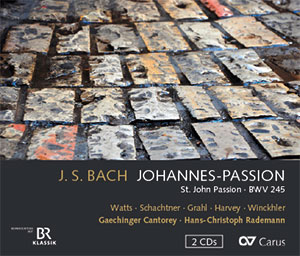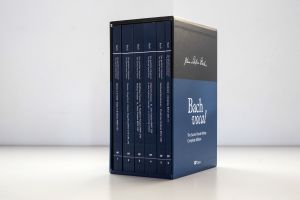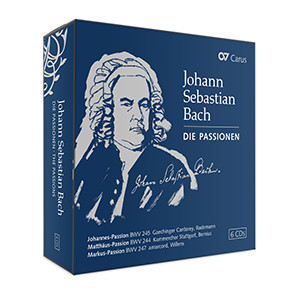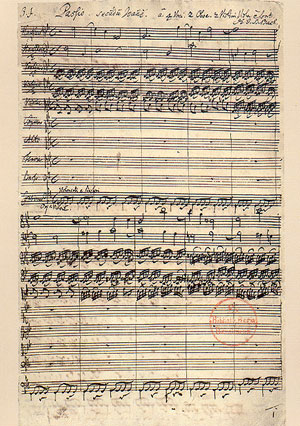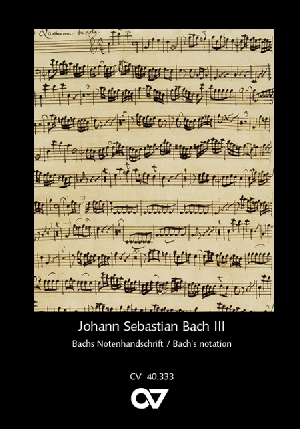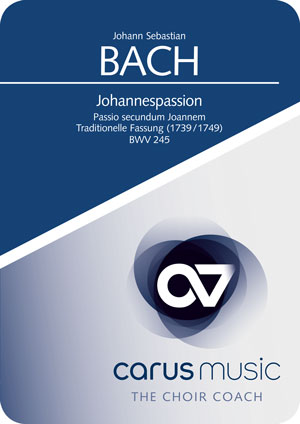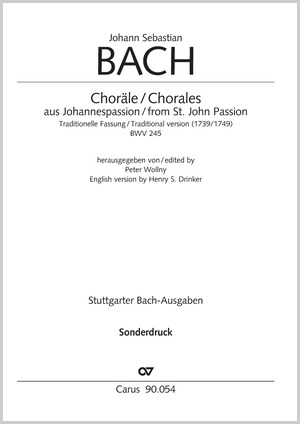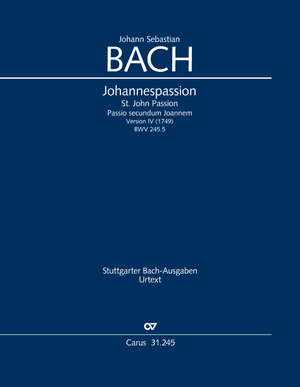
With the unfinished revision (1739) as an appendix. The St. John Passion ranks among the great vocal works from Bach’s Leipzig years. In contrast to his other large-scale choral works, however, Bach never gave this work a definitive final form. Rather, for every performance he made numerous changes. All previous editions of the St. John Passion have combined readings from various layers of sources. The wish often expressed by conductors to perform an authentic version is made possible for the first time with the present edition in this fourth and final version which was performed under Bach’s direction in 1749. At the same time, with the aid of the appendix it is possible to perform the work in the traditional “mixed version”, please use for the "mixed version" the vocal part Carus 31.245/93.
The recording for carus music, the choir choach and the Carus Choir Coach is based on the piano reduction of the traditional version (Carus 31.245/93). The first 10 movements correspond to the appendix in the score (Carus 31.245/00) from p.162ff. (piano reduction Carus 31.245/03, p.150ff.)
Contents
-
Composer
Johann Sebastian Bach
| 1685-1750Johann Sebastian Bach is one of the most important composers of Western music history. He came from a widely ramified musical dynasty, which produced numerous musicians and organists in the Thuringian-Saxon area.
Bach vocal
Ever since Carus-Verlag was founded in 1972, publishing the music of Johann Sebastian Bach has been a special focus for us. In the 2017 Reformation anniversary year we completed the Bach vocal project. Bach's complete sacred vocal works are now available in modern Urtext editions, together with performance material. A complete edition of all the full scores is also available in a high quality box set. Personal details
-
Editor
Peter Wollny
| 1961
-
Vocal score arranger
Paul Horn
| 1922-2016Paul Horn war ein deutscher Kirchenmusiker, Organist, Komponist und Musikwissenschaftler. Er studierte Kirchenmusik und Orgel an der Evangelischen Kirchenmusikschule Esslingen am Neckar bei Hans-Arnold Metzger und Musikwissenschaft, Theologie und Geschichte an der Universität Tübingen. Seine berufliche Laufbahn begann als Kantor an der Evangelischen Michaelskirche in Stuttgart-Degerloch. 1954 wurde er Kantor an der Evangelischen Stadtkirche Ravensburg, eine Position, die er bis zu seiner Pensionierung innehatte. Als Musikwissenschaftler arbeitete Horn bis ins hohe Alter eng mit Carus zusammen. So stammen zahlreiche Carus-Klavierauszüge aus seiner Feder. Personal details
-
Translator
Henry Drinker
-
Translator
Henry Drinker
Reviews
Johann Sebastian Bach: Johannespassion
... Es ist überaus verdienstvoll, diese Fassung der Praxis erschlossen zu haben.
Württembergische Blätter für Kirchenmusik 2/2005
Die Begegnung mit den verschiedenen Fassungen der Johannespassion eröffnet uns die Möglichkeit, Vertrautes neu zu erleben und dabei die Veränderungen und Konstanten eines Vierteljahrhunderts von Bachs Schaffenszeit zu reflektieren.
Jürgen Hinz, Das Orchester 9/2005
I’ve only seen the score, which is excellently produced, easy on the eyes and to handle. There are (or will be) vocal score, parts, organ realisation and libretto. A companion edition of the 1725 version is also in preparation. This is a commendable enterprise. I would suggest that the whole introduction and the prose of the critical commentary be given in English if there is a reprint, and that the 1725 score issued thus; there could also be a little more on performance matters.
Early Music Review April 2003
Bachs „Johannes-Passion” hat eine komplexe Entstehungs- und Aufführungsgeschichte, die in Form einer Konkordanz der vier Fassungen und durch das ausgezeichnete Vorwort bestens dargestellt wird. Als separate Ausgaben werden die Fassungen II (1725) und IV (1749) im gesamten Aufführungsmaterial ediert. Der Klavierauszug von Paul Horn von Fassung IV weist den Vokalstimmen je ein eigenes Liniensystem zu und bringt die Instrumentalstimmen in gut spielbarem Klaviersatz (samt Hinweisen auf die Instrumentation), wobei dem deutschen Originaltext eine englische Übersetzung von Henry S. Drinker in Kursivdruck beigegeben ist.
Singende Kirche 2/2002
... Eine Konkordanz gibt ausführlich Einblick in die Unterschiede der vier Fassungen und der revidierten Partitur. Hier erhält man nicht nur gutes Aufführungsmaterial, sondern auch gleich einen guten Einblick in die aufführungspraktischen Fragen. Sehr schön und auch nützlich sind die Nachdrucke einzelner Blätter aus den Originalhandschriften. Unbedingt empfehlenswert.
Reinhold Ix, Musik im Bistum Essen 2/2002
Frequent questions about this work
Ich möchte die Johannes-Passion in ihrer 1. Fassung von 1724 aufführen. Ist diese auch bei Carus erhältlich oder aus einer der Ausgaben ableitbar?
I would like to perform the St. John Passion in its first version from 1724. Is this version also available from Carus or can it be found in another edition?
 There are no questions and answers available so far or you were unable to find an answer to your specific question about this work? Then click here and send your specific questions to our Customer Services!
There are no questions and answers available so far or you were unable to find an answer to your specific question about this work? Then click here and send your specific questions to our Customer Services!


